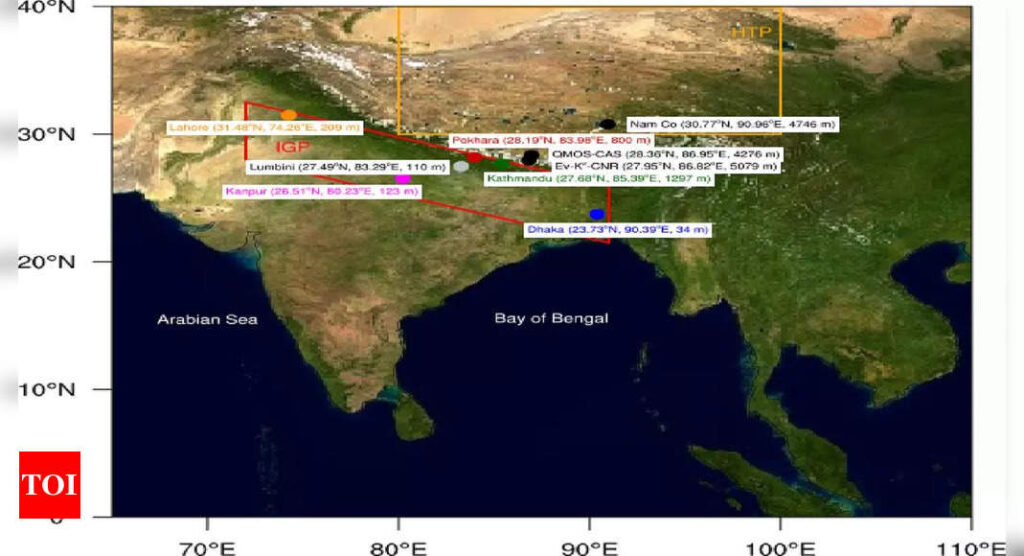[ad_1]
NEW DELHI: In an alarming finding, a study by Isro’s Ahmedabad-based Physical Research Laboratory (PRL) has found that “aerosols are heating up the Himalayas, and will remain a key factor driving climate change over the Hindu Kush–Himalaya–Tibetan Plateau (HKHTP) region”. It also said “aerosols alone account for over 50% of the total warming (aerosols + greenhouse gases) of the lower atmosphere”.
The HKHTP mountain region stretches across eight countries in South Asia from Afghanistan to Myanmar, including Pakistan, India, China, Bangladesh, Bhutan and Nepal and exhibits significant heterogeneity in terms of landscape, precipitation, vegetation, development and livelihood.
This is a first-time analysis of its kind that includes ground-based observations, satellite data and model simulations. It reveals that the aerosol radiative forcing efficiency in the atmosphere is clearly high over the Indo-Gangetic plain and Himalayan foothills with values being greater at higher elevations. This means aerosol radiative forcing efficiency is 2–4 times higher here than over other polluted sites in South and East Asia, owing to higher aerosol optical depth and aerosol absorption, it said.
The research was done by PRL’s senior professor S Ramachandran when he was a senior fellow at Germany-based Research Institute for Sustainability, formerly Institute for Advanced Sustainability Studies, on a sabbatical from the Isro laboratory. Maheswar Rupakheti, Ribu Cherian and Mark G Lawrence helped Ramachandran in the research, whose findings were recently published in the Science of the Total Environment journal.
“We demonstrate that the current state-of-the-art models used in climate assessments significantly underestimate aerosol-induced heating, efficiency and warming over the Hindu Kush–Himalaya–Tibetan Plateau region, indicating a need for a more realistic representation of aerosol properties, especially of black carbon and other aerosols,” the researchers said.
A 2019 report by the International Centre for Integrated Mountain Development (ICIMOD) found that the Hindu-Kush Himalayas are warming faster than the global average, and that the consequences of it in the region were severe. It highlighted that 1.5 degrees Celsius is “too hot” for the Hindu-Kush Himalayas. The PRL study also warned of similar consequences.
“The significant, regionally coherent aerosol-induced warming that we observe in the high altitudes of the region, is a significant factor contributing to increasing air temperature, observed accelerated retreat of the glaciers, and changes in the hydrological cycle and precipitation patterns over this region. Thus, aerosols are heating up the Himalayan climate, and will remain a key factor driving climate change over the region,” the new study said.
The HKHTP mountain region stretches across eight countries in South Asia from Afghanistan to Myanmar, including Pakistan, India, China, Bangladesh, Bhutan and Nepal and exhibits significant heterogeneity in terms of landscape, precipitation, vegetation, development and livelihood.
This is a first-time analysis of its kind that includes ground-based observations, satellite data and model simulations. It reveals that the aerosol radiative forcing efficiency in the atmosphere is clearly high over the Indo-Gangetic plain and Himalayan foothills with values being greater at higher elevations. This means aerosol radiative forcing efficiency is 2–4 times higher here than over other polluted sites in South and East Asia, owing to higher aerosol optical depth and aerosol absorption, it said.
The research was done by PRL’s senior professor S Ramachandran when he was a senior fellow at Germany-based Research Institute for Sustainability, formerly Institute for Advanced Sustainability Studies, on a sabbatical from the Isro laboratory. Maheswar Rupakheti, Ribu Cherian and Mark G Lawrence helped Ramachandran in the research, whose findings were recently published in the Science of the Total Environment journal.
“We demonstrate that the current state-of-the-art models used in climate assessments significantly underestimate aerosol-induced heating, efficiency and warming over the Hindu Kush–Himalaya–Tibetan Plateau region, indicating a need for a more realistic representation of aerosol properties, especially of black carbon and other aerosols,” the researchers said.
A 2019 report by the International Centre for Integrated Mountain Development (ICIMOD) found that the Hindu-Kush Himalayas are warming faster than the global average, and that the consequences of it in the region were severe. It highlighted that 1.5 degrees Celsius is “too hot” for the Hindu-Kush Himalayas. The PRL study also warned of similar consequences.
“The significant, regionally coherent aerosol-induced warming that we observe in the high altitudes of the region, is a significant factor contributing to increasing air temperature, observed accelerated retreat of the glaciers, and changes in the hydrological cycle and precipitation patterns over this region. Thus, aerosols are heating up the Himalayan climate, and will remain a key factor driving climate change over the region,” the new study said.
[ad_2]
Source link











More Stories
We can’t wait to face India in the final: Pat Cummins | Cricket News
Railways plans 3,000 additional trains in next 4-5 years to minimise number of waitlisted tickets | India News
Faridabad: Man dies after ‘falling from hotel room window’ while partying with friends